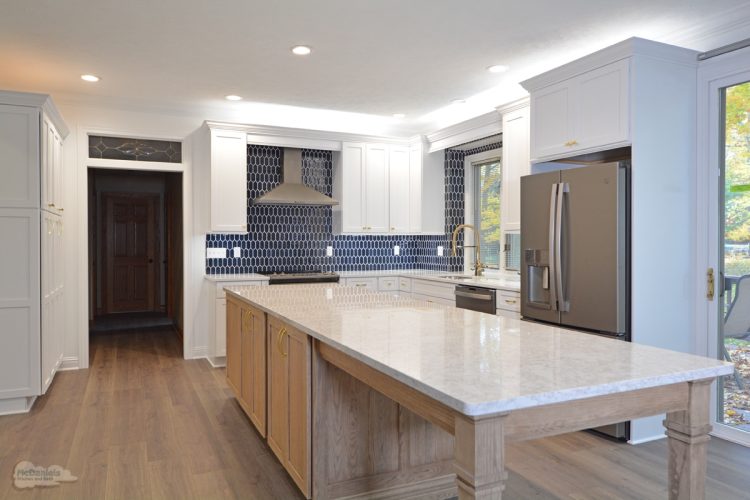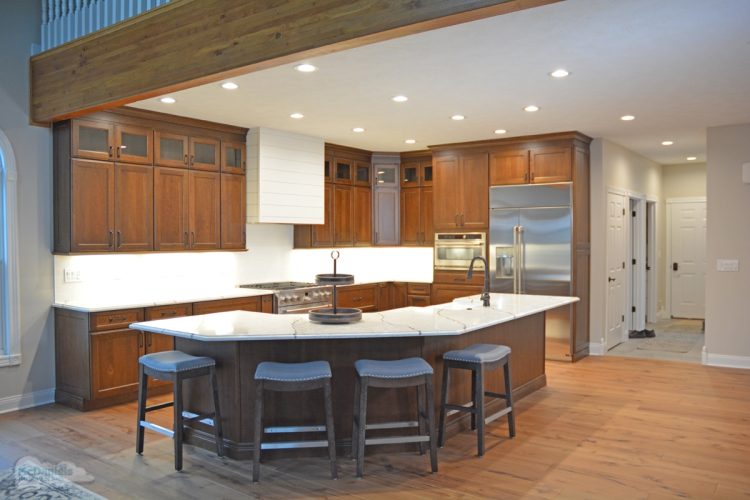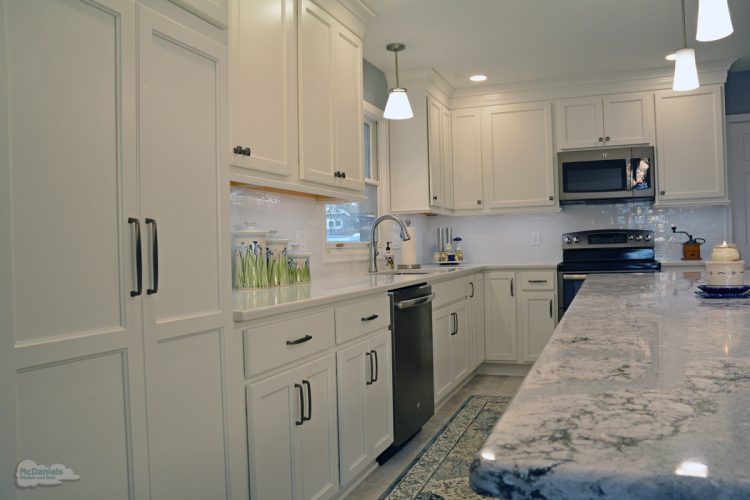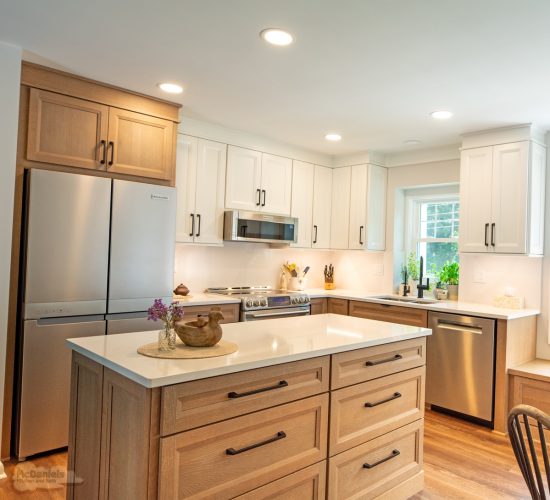Planning a Family Friendly Kitchen Design
By McDaniels Kitchens and Bath|Kitchen Design
Are you considering a kitchen design this year? The kitchen is the heart of the home, where cooking, gathering with family and friends, entertaining, and daily family life happen. If you want your kitchen to have staying power, make sure you design your kitchen to support your family’s needs, not just for now, but for years to come. Plan a kitchen that grows with your family, balances style and functionality, and supports your lifestyle for the duration of your kitchen. It will make daily life easier and special occasions more enjoyable!
McDaniels Kitchen and Bath has extensive experience designing customized, functional, and beautiful kitchens to fit our clients’ needs, from a kitchen for your first home to an accessible space designed for aging in place. With our proven design process, we will help you get the most out of your remodeling budget and create a kitchen that fits your family. Let’s get started by exploring some of the top things you need to know when planning a family-friendly kitchen design.

Assessing Your Family’s Unique Needs
Any remodel must start by assessing your needs, whether you are embarking on a kitchen or bathroom design or a whole-home remodel. Each family is unique, so your new kitchen’s style and functionality requirements will also be individual.
Start by evaluating your daily activities in the kitchen and how you use your kitchen. This could include cooking, dining, handing out after-school snacks, and fixing school lunches, but also homework help, craft time, and more. Consider also who uses the kitchen, including parents, kids, pets, guests, and elderly family members.
Take stock of what works and what doesn’t work in your current kitchen design, which will help you decide what you want to change and determine the scope of your project. Think about traffic patterns, such as where bottlenecks or hazards happen in your existing kitchen, and how you want traffic to flow throughout your kitchen.
Evaluate storage needs, depending on your family’s preferences, how often you cook, and what else you do in your kitchen. This could include a pantry, cookware storage, kids’ lunch supplies, water bottles, bakeware, pet supplies, and other key items you use regularly. You might consider finding space away from the main kitchen storage to keep more seldom-used items, such as party supplies, holiday tableware, or barbecue tools.

Designing for Now and the Future
Your kitchen must be created to fit your family’s needs. Since a new kitchen is an investment in your home, you must future-proof your design so it suits your family for the lifespan of the kitchen.
Plan your design for the current stage of your family life, whether you have young children, teenagers, or a multi-generational household. Consider your future needs, such as accommodating growing kids, their evolving activities, aging in place, or changing mobility needs. Think about whether you plan to involve your kids in cooking and baking, if they will have friends coming over to visit, and whether you frequently entertain guests.
Opt for adaptable or universal design features like adjustable height countertops, customized storage features, and flexible seating options to fit everyone who uses your kitchen design. Ensure you have enough space and seating for growing children and guests. Plan appropriate seating – very young children may struggle with tall barstools, but can comfortably sit at a banquette or breakfast nook. Choose appliance sizes and features that fit your family size and long-term needs.

Choosing a Style That Fits Your Home and Lifestyle
When planning any kitchen design, you should select a design that fits your home’s architectural style to create a cohesive look for your home. Today’s kitchens are an integral part of home life and often connected to adjacent spaces or part of an open plan first floor.
Determine your design style and ensure it is comfortable and livable for your family’s needs, whether that is modern farmhouse, transitional, traditional, or contemporary. Choose colors and finishes for your cabinets, countertops, backsplash, wall paint, accessories, and more that fit your style and are family-friendly. Focus on functionality over style so you can create a kitchen that works for you, but don’t sacrifice beauty. You can find a design style and materials that give you both!

Selecting an Efficient and Functional Layout
The layout is the foundation of any room in your home, and is especially important when planning a busy kitchen design. There are a variety of popular layouts for kitchen designs that are particularly family-friendly:
- Open concept kitchens are ideal for keeping an eye on the kids and spending time with family and friends.
- U- or L-shaped kitchens with islands provide ample storage and workspace while promoting an efficient flow of traffic throughout the space and between rooms.
- Galley kitchens are ideal for smaller spaces, maximizing storage and workspace while still being efficient.
In addition to choosing a basic layout, you should design your kitchen according to work zones for key functions. Ensure there is enough space for more than one cook, along with easy access to key ingredients and cooking tools. Include storage for essentials in each specialized zone throughout the kitchen. Position sinks, dishwashers, workspaces, and trash cans conveniently for family use. Add extra seating in island stools, at a peninsula, or a banquette/breakfast nook for informal meals, craft projects, or homework help.

Creating Functional Zones for the Entire Family
Kitchen zones are essential to ensuring every function and every family member can safely and efficiently use your kitchen. Create zones for everything you plan to do in your kitchen, from cooking to homework help.
- Cooking zone: includes your range, prep space, spice and oils storage, cutting board storage, knives, pots and pans, and other cooking tools.
- Cleaning zone: includes the sink, dishwasher, trash/recycling pullouts, and a drying area for handwashing pots, pans, and more.
- Food storage zone: includes the fridge and pantry, but could also incorporate a kids’ snack drawer and beverage refrigerator.
- Dining zone: incorporate seating to fit your family’s daily needs and guests when you entertain, including seats at your island, peninsula, a breakfast nook, or kitchen table.
- Homework zone: with kids, there is always homework, so include a quiet area with outlets, lighting, and storage for school supplies.
- Entertaining zone: whether it is the kids’ friends coming over or a cocktail night with your neighbors, include a beverage refrigerator, coffee station, or wine bar to enhance social gatherings.
- Pet zone: include a built-in food and water station, pull-out storage for food/treats/toys, and space for your pet’s bed away from the main foot traffic.
Tailor storage, materials, and seating in each zone to that particular task. Make sure your zones work together in your chosen kitchen layout to keep workspaces separate from entertainment areas, and kids safely away from hot ovens.

Prioritizing Safety and Universal Design
Safety should always be considered when designing a kitchen, but it is even more important in a family-friendly kitchen design. This is especially so if you have young children or a multi-generation household. Here are a few key safety features to consider:
- Rounded countertop edges are ideal to avoid injuries from bumping into them.
- Anti-slip flooring reduces falls, especially for young children and elderly family members.
- With soft-close cabinets and drawers, you can prevent pinched fingers.
- Add cabinet locks or high storage for dangerous tools, knives, and cleaning products.
- Include universal design features like wide walkways, easy-to-access pull-out storage, and a multi-layered lighting design.

Choosing Durable, Easy-to-Clean Materials
In a busy home, kitchens are the center of family life. This also means they are used constantly and are a focal point for messes! From babies exploring their first foods to messy toddlers and teenagers looking for a snack after sports training, it’s almost impossible to avoid dirt, smudges, and mess in a kitchen. Constant use can also cause wear and tear on cabinets, floors, and more. By choosing quality, durable materials, particularly ones that are simple to maintain and clean, your kitchen will last longer and stay looking good as new.
For cabinets, go for sturdy, well-constructed cabinets in high-quality materials. Choose a tough finish that is scratch-resistant, simple to clean, and easy to maintain.
Countertops benefit from a hard-wearing, nonporous, stain-resistant surface. Select granite, quartz, or solid surface countertops provide durability and stain resistance.
Kitchen floors take a constant beating from foot traffic, pets’ claws, heavy items being dropped, and more. It is also impossible to avoid spills and splatter on a kitchen floor when cooking, serving food, and eating. Luxury Vinyl Tile/Plank (LVT/P), tile, or engineered hardwood are ideal for durability and easy cleaning.
Backsplashes must look great while withstanding grease and food splatters from food prep and cooking. Choose stain-resistant tile or a quartz slab backsplash for an ideal surface that can withstand anything and be easily cleaned.
Paint finishes for your walls should ideally be scrubbable and stain-resistant. For appliances, faucets, and hardware, consider going for fingerprint- and smudge-resistant finishes.

Additional Family-Friendly Features to Consider
To finish off your kitchen design and make it truly family-friendly, here are a few more key features you could include in your kitchen remodel:
- Smart kitchen features such as voice-controlled lighting, smart appliances, and motion or voice-activated faucets.
- Built-in charging stations for devices to keep devices away from water and cooking areas, and messy cables organized.
- Extra-large sinks or double sinks that provide flexibility in a busy family kitchen.
- Message centers with cork boards, whiteboards, chalkboards, or digital assistants.
- Custom storage for kids’ school supplies, craft products, or sports equipment, either in your kitchen or in an adjacent area such as a utility or mudroom.
- Balance open shelving and closed storage depending on your needs – open storage for display or easy access, and closed storage to manage clutter or close away items you want out of reach of young kids.

Let’s Plan Your Family-Friendly Kitchen Design!
If you are getting ready to create a family-friendly kitchen design, choose design features that balance style, safety, efficiency, and adaptability. By creating a design that is tailored to your home, your family, and your lifestyle, you will have a space that enhances your family’s life now and into the future. Our experienced design team will collaborate with you to create a personalized design with quality materials that you will love. Contact us today to get started!
